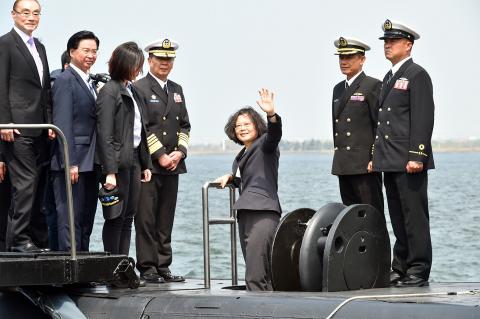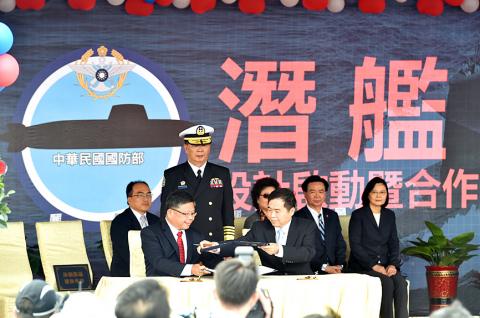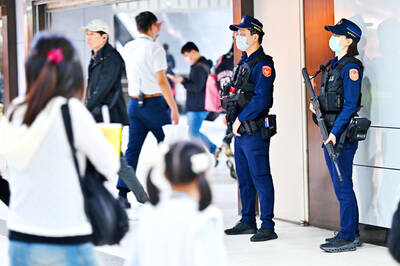The nation is hoping to build its first homegrown submarines within eight years and commission them into service within a decade, the shipbuilder tasked with carrying out the program said yesterday.
CSBC Corp, Taiwan (台灣國際造船) chairman Cheng Wen-lung (鄭文隆) said there were problems that needed to be worked out because Taiwan lacks experience in building submarines, but added that the difficulties were being addressed.
CSBC, the nation’s only listed shipbuilder, has built more than 100 ships for the navy and will use that experience in developing the local submarine program, he added.

Photo: Chang Chung-i, Taipei Times
Cheng’s comments came as CSBC and the Chungshan Institute of Science and Technology signed a memorandum of understanding (MOU) with the navy earlier yesterday in Kaohsiung to jointly build submarines for the military.
The project is part of a broader initiative to develop an independent national defense industry.
The project will have two main phases, the MOU said.

Photo: Chang Chung-i, Taipei Times
The first will be to complete the design for the submarines and will have a budget of about NT$2 billion (US$65.66 million), Cheng said.
The second stage will involve building the submarines, he said, without giving any cost projections for the vessels or estimates of how many submarines would be built.
According to the schedule, the indigenous submarines are to be completed within eight years and then commissioned into service within a decade, he said.
Cheng was asked about the planned submarines’ design and whether it would be based on the designs of existing submarines in the navy’s fleet, which were purchased from the US in the 1970s and the Netherlands in the 1980s.
“The design will be based on a model that meets the needs of Taiwan’s self-defense,” he said.
Institute vice president Gao Chung-hsing (杲中興) said that the most important part of the program is building a system that integrates all equipment and ensures the safety of ships operating underwater.
The institute will cooperate with CSBC in these areas, Gao said.
Yesterday’s signing was also witnessed by President Tsai Ing-wen (蔡英文), who said the construction of submarines is the most challenging aspect of the nation’s policy to create an independent national defense industry.
The government will exhaust all means and pool its resources to solve any problems associated with building the submarines, she said.
Minister of National Defense Feng Shih-kuan (馮世寬) also attended the signing ceremony, which was preceded by the formal send-off of a fleet of navy vessels on a training mission that will include goodwill visits to some of the nation’s diplomatic allies.
During the ceremony, Tsai boarded the Hai Lung-class submarine the Hai Hu in Zuoying Military Harbor to watch a simulation of a torpedo launch.
Taiwan has long tried to acquire submarines from other countries with little success because of their reluctance to upset China.
In 2001, then-US president George W. Bush authorized the sale of eight diesel-electric submarines to Taiwan, but the deal never came to fruition because of political wrangling in Taiwan and questions over whether the US, which did not produce conventional submarines at the time, could supply the vessels.

TRAGEDY STRIKES TAIPEI: The suspect died after falling off a building after he threw smoke grenades into Taipei Main Station and went on a killing spree in Zhongshan A 27-year-old suspect allegedly threw smoke grenades in Taipei Main Station and then proceeded to Zhongshan MRT Station in a random killing spree that resulted in the death of the suspect and two other civilians, and seven injured, including one in critical condition, as of press time last night. The suspect, identified as a man surnamed Chang Wen (張文), allegedly began the attack at Taipei Main Station, the Taipei Fire Department said, adding that it received a report at 5:24pm that smoke grenades had been thrown in the station. One man in his 50s was rushed to hospital after a cardiac arrest

A car bomb killed a senior Russian general in southern Moscow yesterday morning, the latest high-profile army figure to be blown up in a blast that came just hours after Russian and Ukrainian delegates held separate talks in Miami on a plan to end the war. Kyiv has not commented on the incident, but Russian investigators said they were probing whether the blast was “linked” to “Ukrainian special forces.” The attack was similar to other assassinations of generals and pro-war figures that have either been claimed, or are widely believed to have been orchestrated, by Ukraine. Russian Lieutenant General Fanil Sarvarov, 56, head

SAFETY FIRST: Double the number of police were deployed at the Taipei Marathon, while other cities released plans to bolster public event safety Authorities across Taiwan have stepped up security measures ahead of Christmas and New Year events, following a knife and smoke bomb attack in Taipei on Friday that left four people dead and 11 injured. In a bid to prevent potential copycat incidents, police deployments have been expanded for large gatherings, transport hubs, and other crowded public spaces, according to official statements from police and city authorities. Taipei Mayor Chiang Wan-an (蔣萬安) said the city has “comprehensively raised security readiness” in crowded areas, increased police deployments with armed officers, and intensified patrols during weekends and nighttime hours. For large-scale events, security checkpoints and explosives

PUBLIC SAFETY: The premier said that security would be tightened in transport hubs, while President Lai commended the public for their bravery The government is to deploy more police, including rapid response units, in crowded public areas to ensure a swift response to any threats, President William Lai (賴清德) said yesterday after a knife attack killed three people and injured 11 in Taipei the previous day. Lai made the remarks following a briefing by the National Police Agency on the progress of the investigation, saying that the attack underscored the importance of cooperation in public security between the central and local governments. The attack unfolded in the early evening on Friday around Taipei Main Station’s M7 exit and later near the Taipei MRT’s Zhongshan